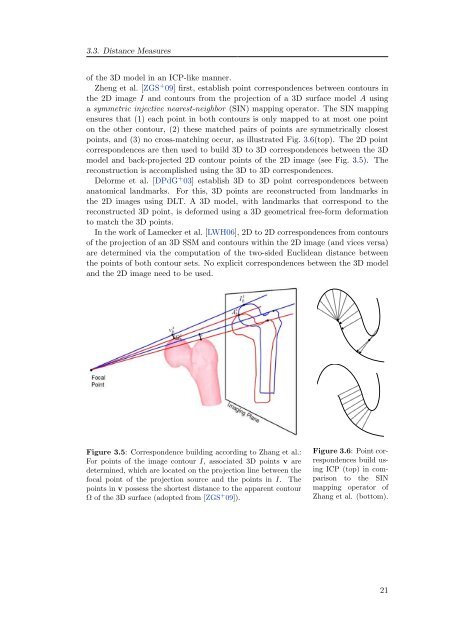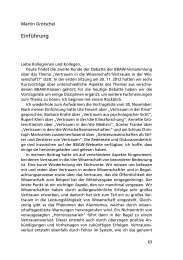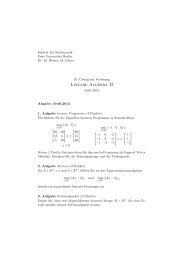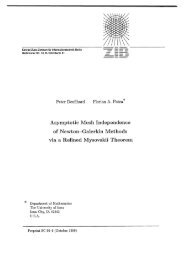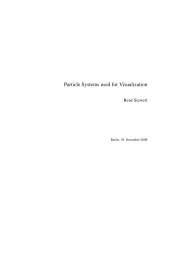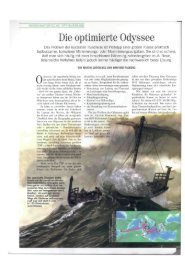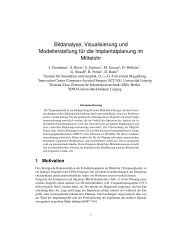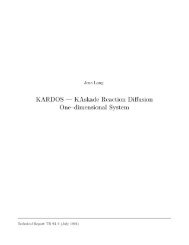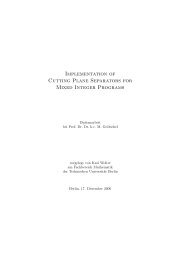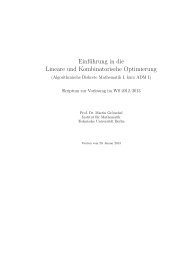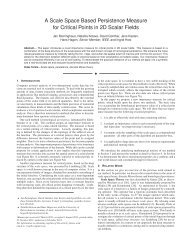3D Reconstruction of the Human Rib Cage from 2D Projection ... - ZIB
3D Reconstruction of the Human Rib Cage from 2D Projection ... - ZIB
3D Reconstruction of the Human Rib Cage from 2D Projection ... - ZIB
Create successful ePaper yourself
Turn your PDF publications into a flip-book with our unique Google optimized e-Paper software.
3.3. Distance Measures<br />
<strong>of</strong> <strong>the</strong> <strong>3D</strong> model in an ICP-like manner.<br />
Zheng et al. [ZGS + 09] first, establish point correspondences between contours in<br />
<strong>the</strong> <strong>2D</strong> image I and contours <strong>from</strong> <strong>the</strong> projection <strong>of</strong> a <strong>3D</strong> surface model A using<br />
a symmetric injective nearest-neighbor (SIN) mapping operator. The SIN mapping<br />
ensures that (1) each point in both contours is only mapped to at most one point<br />
on <strong>the</strong> o<strong>the</strong>r contour, (2) <strong>the</strong>se matched pairs <strong>of</strong> points are symmetrically closest<br />
points, and (3) no cross-matching occur, as illustrated Fig. 3.6(top). The <strong>2D</strong> point<br />
correspondences are <strong>the</strong>n used to build <strong>3D</strong> to <strong>3D</strong> correspondences between <strong>the</strong> <strong>3D</strong><br />
model and back-projected <strong>2D</strong> contour points <strong>of</strong> <strong>the</strong> <strong>2D</strong> image (see Fig. 3.5). The<br />
reconstruction is accomplished using <strong>the</strong> <strong>3D</strong> to <strong>3D</strong> correspondences.<br />
Delorme et al. [DPdG + 03] establish <strong>3D</strong> to <strong>3D</strong> point correspondences between<br />
anatomical landmarks. For this, <strong>3D</strong> points are reconstructed <strong>from</strong> landmarks in<br />
<strong>the</strong> <strong>2D</strong> images using DLT. A <strong>3D</strong> model, with landmarks that correspond to <strong>the</strong><br />
reconstructed <strong>3D</strong> point, is deformed using a <strong>3D</strong> geometrical free-form deformation<br />
to match <strong>the</strong> <strong>3D</strong> points.<br />
In <strong>the</strong> work <strong>of</strong> Lamecker et al. [LWH06], <strong>2D</strong> to <strong>2D</strong> correspondences <strong>from</strong> contours<br />
<strong>of</strong> <strong>the</strong> projection <strong>of</strong> an <strong>3D</strong> SSM and contours within <strong>the</strong> <strong>2D</strong> image (and vices versa)<br />
are determined via <strong>the</strong> computation <strong>of</strong> <strong>the</strong> two-sided Euclidean distance between<br />
<strong>the</strong> points <strong>of</strong> both contour sets. No explicit correspondences between <strong>the</strong> <strong>3D</strong> model<br />
and <strong>the</strong> <strong>2D</strong> image need to be used.<br />
Figure 3.5: Correspondence building according to Zhang et al.:<br />
For points <strong>of</strong> <strong>the</strong> image contour I, associated <strong>3D</strong> points v are<br />
determined, which are located on <strong>the</strong> projection line between <strong>the</strong><br />
focal point <strong>of</strong> <strong>the</strong> projection source and <strong>the</strong> points in I. The<br />
points in v possess <strong>the</strong> shortest distance to <strong>the</strong> apparent contour<br />
Ω <strong>of</strong> <strong>the</strong> <strong>3D</strong> surface (adopted <strong>from</strong> [ZGS + 09]).<br />
Figure 3.6: Point correspondences<br />
build using<br />
ICP (top) in comparison<br />
to <strong>the</strong> SIN<br />
mapping operator <strong>of</strong><br />
Zhang et al. (bottom).<br />
21


